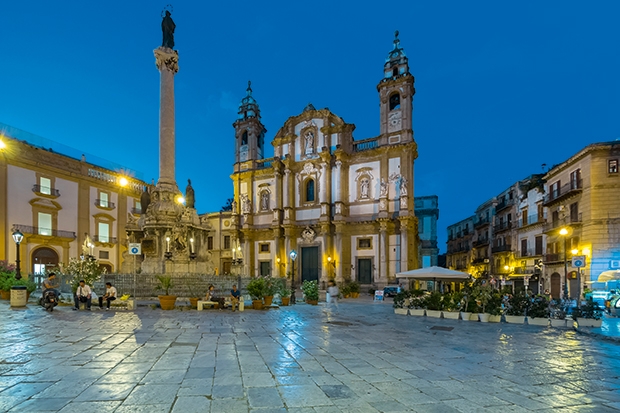The Arabs invaded Sicily in the ninth century, leaving behind mosques and pink-domed cupolas. In the Sicilian capital of Palermo, Arab rule was generally tolerant, its dolce far niente evocative of sultans, minarets, concubines and other jasmine-scented delights. Walking round Palermo today, however, one is assailed by less lovely smells. Parts of the city remain unreconstructed since the Allies bombed it in 1943: fire-blackened palazzi and rubble-strewn slumlands speak of the Mafia’s systematic ransacking of the public coffers. A still darker side of Palermo finds expression in the 19th-century catacombs of the Capuchin friary, situated near the Arab-Fatamid pleasure palace of La Zisa (‘the magnificent’). Some 8,000 embalmed corpses moulder in the catacombs; segregated according to lawyers, surgeons, university professors, there is even a section for babies and virgins. The Capuchin priests in their coffee-brown robes appear to be the best preserved. (Cappuccino gets its name from the colour of the order’s habit; personally I can’t bear the froth.)
With its obscure exuberance of life and the souk-like atmosphere of its markets, Sicily is far removed from the gracious suavities of Tuscany. Ghastly British Tuscanites such as Tony Blair, Sting and David Cameron who descend on the hills round Florence over the summer to enact their ‘Toujours Tuscany’ dreams are, thankfully, not in evidence. John Julius Norwich, the historian, has been visiting Sicily for half a century or more. Sicily: A Short History from the Ancient Greeks to Cosa Nostra is his heartfelt hosanna to the Mediterranean island and its Arabic, Norman and Baroque glories.
No history of Sicily would be complete without mention of the Mafia, and Norwich does not disappoint. In his reckoning, the Mafia began in the Sicilian countryside in the 1860s following Italy’s unification at the hands of Garibaldi and Cavour.








Comments
Join the debate for just £1 a month
Be part of the conversation with other Spectator readers by getting your first three months for £3.
UNLOCK ACCESS Just £1 a monthAlready a subscriber? Log in